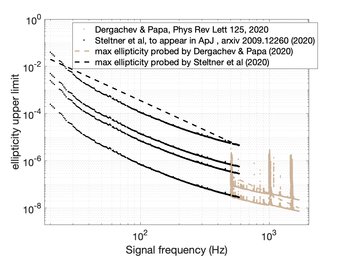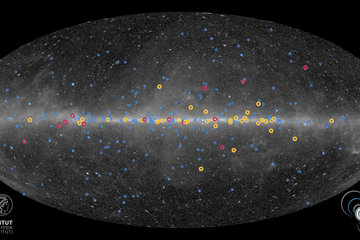A milestone in the race to find the first continuous gravitational wave signal
AEI scientists achieve breakthrough sensitivity
All so far observed gravitational-wave signals have been very short, produced in the final seconds of black hole and neutron star coalescences. There exist other signals, that are continously “ON”. Such continuous signals are much weaker than the short-lived ones but this drawback can be partially made up by utilizing more data and at the cost of a much greater algorithmic complexity of the search. One promising source of continuous gravitational waves are slightly deformed (non-axisymmetric) neutron stars. Our new results explore deformations smaller than 10 parts in a billion. This corresponds to star deformations as large as several widths of human hair! We find no signal candidates but identify a few outliers. Albeit it is unlikely that these candidates come from signals that precisely follow the assumed model, and may well come from coherent disturbances in the data, they will be explored very carefully as new data becomes available – something one can only do with continuous waves. Between the two papers, we search for signals from anywhere in the sky and with frequencies between 20 Hz and 1700 Hz.
Paper abstract for “Results from the first all-sky search for continuous gravitational waves from small-ellipticity sources”
We present the results of an all-sky search for continuous gravitational wave signals with frequencies in the 500-1700 Hz range targeting neutron stars with ellipticity of 1e-8. The search is done on LIGO O2 data using the Falcon analysis pipeline. The results presented here double the sensitivity over any other result on the same data. The search is capable of detecting low ellipticity sources up to 170 pc. We establish strict upper limits which hold for worst-case signal parameters. We list outliers uncovered by the search, including several which we cannot associate with any known instrumental cause.
Paper abstract for “Einstein@Home all-sky search for continuous gravitational waves in LIGO O2 public data”

We conduct an all-sky search for continuous gravitational waves in the LIGO O2 data from the Hanford and Livingston detectors. We search for nearly-monochromatic signals with frequency between 20.0 Hz and 585.15 Hz and spin-down between -2.6e-9 Hz/s and 2.6e-10 Hz/s. We deploy the search on the Einstein@Home volunteer-computing project and follow-up the waveforms associated with the most significant results with eight further search-stages, reaching the best sensitivity ever achieved by an all-sky survey up to 500 Hz. Six of the inspected waveforms pass all the stages but they are all associated with hardware-injections, which are fake signals simulated at the LIGO detector for validation purposes. We recover all these fake signals with consistent parameters. No other waveform survives, so we find no evidence of a continuous gravitational wave signal at the detectability level of our search. We constrain the h0 amplitude of continuous gravitational waves at the detector as a function of the signal frequency, in half-Hz bins. The most constraining upper limit at 163.0 Hz is h0 = 1.3e25, at the 90% confidence level. Our results exclude neutron stars rotating faster than 5 ms with equatorial ellipticities larger than 1e-7 closer than 100 pc. These are deformations that neutron star crusts could easily support, according to some models.












